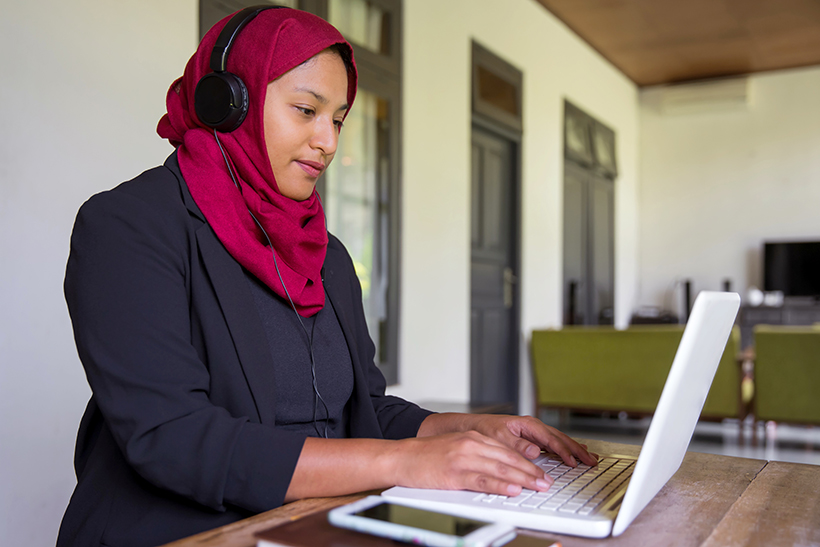This is an excerpt from “Teaching Hybrid Online College Composition Classes to International Students during COVID-19: Equity, Diversity, Inclusiveness, and Community Building” by NCTE member Qianqian Zhang-Wu, from English Leadership Quarterly (October 2020). Read the full article here.
In this article, the author discusses the urgency to support international students during the COVID-19 global pandemic in ways that promote equity and inclusion in US college composition classrooms, which are a potential site for community building, empowerment, and care.
Ever since the abrupt transition to online teaching due to the COVID-19 outbreak back in spring 2020, there have been many controversies between synchronous and asynchronous online teaching. Some colleagues prefer synchronous teaching, believing that the real-time interaction and the sense of community built through this experience is empowering to students and teachers alike. However, others disagree, suggesting that synchronous lectures may not be the best option given their logistical difficulties (e.g., scheduling, internet connectivity) and teacher-centered nature (Supiano, 2020).
From an equity and inclusion perspective, I argue that in US college composition classrooms, exclusive synchronous instruction is likely to put international students at a disadvantage due to the challenges of different time zones, difficulties in active participation, and unequal quality of knowledge acquisition. Firstly, since international students are from all over the world, the drastic variation in time differences tends to pose challenges to synchronous teaching and learning. For instance, if I were to have a synchronous online lecture at noon (EST), my Chinese, Japanese, and Korean international students will have to join at midnight and 1 a.m., while my Indonesian students need to go online at 11 p.m. In this scenario, exclusive synchronous online teaching could result in unfair learning conditions with those who are in the US joining the class during the day and international students burning their midnight oil to catch up with remote learning.
Even assuming international students were all able to cope with the remarkable time differences throughout the semester, they are still subject to various difficulties in oral participation in synchronous online classrooms.
The challenging nature of entering conversations in cyberspace, the fear of talking over people, and the concerns about not being able to express oneself clearly due to language barriers could further silence international students during online discussions and burden their already overly stressed minds during the pandemic.
Although one may disagree, some argue that since all synchronous lectures could be recorded, international students could simply choose to watch a video recording afterward and learn at their own convenience. While this indeed is a possibility, the quality of learning in passively watching recordings (let’s assume that the recordings were always clear with good sound quality) is nothing compared to actual participation in a live, interactive online class.
Furthermore, such passive receptive “individualized” learning may also exclude international students from valuable learning community experiences and peer review activities that are both key components in US college composition classrooms. Unless assessment of students’ learning results (i.e., quizzes and essays) are also adjusted based on students’ varying accessibility to quality learning materials, making comprehensive synchronous learning only feasible for some but not others jeopardizes educational equity and inclusiveness.
While arguing against exclusive synchronous teaching, I by no means insist that we should go to the other extreme to deliver all online instruction asynchronously. Instead, I argue for a hybrid online instruction model, in which both synchronous and asynchronous elements are present to ensure quality, fairness, accessibility, flexibility, and community building.
On the one hand, the asynchronous components in online teaching could create an inclusive learning environment that may alleviate the difficulties posed by time zone differences and reduce some learners’ anxieties in actively engaging in real-time online discussions. On the other hand, the synchronous elements in online teaching make it possible to create a community of practice (Lave & Wenger 1991; Wenger, 1998), making college composition classrooms an ideal space to facilitate international students’ linguistic and academic transition and a safe zone to practice writing as healing and reflection during the current global crisis.
 Qianqian Zhang-Wu is an assistant professor of English and the Director of Multilingual Writing at Northeastern University, Boston, Massachussetts. She is a member of the 2020–2022 cohort of the NCTE Research Foundation’s Cultivating New Voices among Scholars of Color program.
Qianqian Zhang-Wu is an assistant professor of English and the Director of Multilingual Writing at Northeastern University, Boston, Massachussetts. She is a member of the 2020–2022 cohort of the NCTE Research Foundation’s Cultivating New Voices among Scholars of Color program.
Not an English Leadership Quarterly subscriber? Find details here.
It is the policy of NCTE in all publications, including the Literacy & NCTE blog, to provide a forum for the open discussion of ideas concerning the content and the teaching of English and the language arts. Publicity accorded to any particular point of view does not imply endorsement by the Executive Committee, the Board of Directors, the staff, or the membership at large, except in announcements of policy, where such endorsement is clearly specified.

